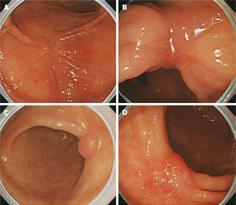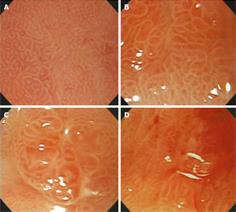Copyright
©2009 The WJG Press and Baishideng.
World J Gastroenterol. Jan 21, 2009; 15(3): 349-355
Published online Jan 21, 2009. doi: 10.3748/wjg.15.349
Published online Jan 21, 2009. doi: 10.3748/wjg.15.349
Figure 1 Conventional endoscopic characteristics of scar lesions.
A: Height; flat, non-nodular and iso-color; B: Height; depressed, non-nodular and erythematous color; C: Height; elevated, non-nodular, and iso-color; D: Height; elevated, distorted nodular, and erythematous color.
Figure 2 Magnifying images of scar lesion showing fine mucosal pit patterns.
The four pit patterns of sulci and ridges identified are as follows: A: Typ I pit; small round, normal-like pit pattern; B: Type II pit; short rod or tubular pit pattern; C: Type III pit; branched or gyrus-like pit pattern; D: Type IV pit; destroyed pit pattern.
- Citation: Lee TH, Chung IK, Park JY, Lee CK, Lee SH, Kim HS, Park SH, Kim SJ, Cho HD, Hwangbo Y. Usefulness of magnifying endoscopy in post-endoscopic resection scar for early gastric neoplasm: A prospective short-term follow-up endoscopy study. World J Gastroenterol 2009; 15(3): 349-355
- URL: https://www.wjgnet.com/1007-9327/full/v15/i3/349.htm
- DOI: https://dx.doi.org/10.3748/wjg.15.349














